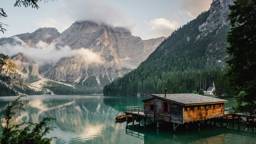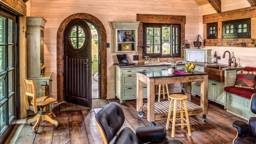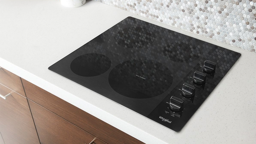Sizing It Up
Generally speaking, a tankless unit with a capacity of 150,000 to 180,000 BTUs should be sufficient for a typical one-bathroom home.
The correct size for your specific household needs, however, depends on the temperature of the groundwater as well as the flow rate of the hot-water fixtures and appliances (showerheads, bathroom sinks, dishwashers, clothes washers, etc.). The colder your groundwater, the lower the flow rate the tankless unit will be able to provide, so you’ll need a higher-capacity unit.
David Chisolm, brand manager for A.O. Smith, the manufacturer and distributor of Takagi tankless water heaters, says it’s imperative to identify your peak hot-water usage, usually measured in gallons per minute (GPM) or gallons per hour (GPH). This is done by adding up the flow rates of all fixtures and appliances. Typically, each fixture has a flow rate of 2.5 GPM, so to run two showers and a load of laundry simultaneously, you’ll need a tankless unit that can provide 7.5 GPM.
Note: If your hot water usage areas (say, a kitchen and bathroom) are on opposite ends of your cabin, it does take a bit for the hot water to move through the long run of pipes. In that situation, you may want to install two separate water heaters for less water waste and more instant hot water.
Installation Requirements
If you’re replacing a standard, tank-type water heater with a tankless system, know that there will be some special installation requirements. “Tankless products require more gas because they have to heat water up on the fly, so they have a much larger burner – as much as 200,000 BTUs compared to 40,000 for a typical tank-type unit,” says Chisolm. “Therefore, you’ll need to upgrade to a ¾-inch gas line.” Tankless heaters also require a special stainless-steel venting material that isn’t used with tank-style heaters.
Including materials (gas line, vent pipe, etc.) and installation, expect to spend approximately $2,000 to $3,000 on a tankless system. The exact cost will vary according to the length of the new gas line and how much venting is needed. Unlike most tank-style heaters, which last about 10 years, tankless units have an average useful life of 15 to 20 years.
While most tankless heaters run on natural gas or propane, electric units are available for point-of-use applications, such as under a kitchen counter. Just keep in mind that when you turn on the tap, there will be a short delay while the water heats up. An electric tankless unit won’t give you instant hot water unless you install a recirculating pump.
Maintenance
Not much maintenance is required; manufacturers recommend flushing the copper heat exchanger once a year to eliminate sediment. The Sonnees purchased an optional washout kit for this purpose: two valves installed in the water line going into and out of the heater. All they need to do is hook up a garden hose to the heater and run water through it to keep deposits from forming. For Nancy, there’s no question she made the right choice for her cabin. “We’ve been really happy with it,” she says. “I have no complaints.”
Still tethered to a tank-style water heater, Susan Bady hopes one day to go tankless.
Reader Resources:
• Rinnai, www.rinnai.us
• Rheem, www.rheem.com
• Noritz, www.noritz.com
• A.O. Smith/Takagi, www.hotwater.com.
Generally speaking, a tankless unit with a capacity of 150,000 to 180,000 BTUs should be sufficient for a typical one-bathroom home.
The correct size for your specific household needs, however, depends on the temperature of the groundwater as well as the flow rate of the hot-water fixtures and appliances (showerheads, bathroom sinks, dishwashers, clothes washers, etc.). The colder your groundwater, the lower the flow rate the tankless unit will be able to provide, so you’ll need a higher-capacity unit.
David Chisolm, brand manager for A.O. Smith, the manufacturer and distributor of Takagi tankless water heaters, says it’s imperative to identify your peak hot-water usage, usually measured in gallons per minute (GPM) or gallons per hour (GPH). This is done by adding up the flow rates of all fixtures and appliances. Typically, each fixture has a flow rate of 2.5 GPM, so to run two showers and a load of laundry simultaneously, you’ll need a tankless unit that can provide 7.5 GPM.
Note: If your hot water usage areas (say, a kitchen and bathroom) are on opposite ends of your cabin, it does take a bit for the hot water to move through the long run of pipes. In that situation, you may want to install two separate water heaters for less water waste and more instant hot water.
Installation Requirements
If you’re replacing a standard, tank-type water heater with a tankless system, know that there will be some special installation requirements. “Tankless products require more gas because they have to heat water up on the fly, so they have a much larger burner – as much as 200,000 BTUs compared to 40,000 for a typical tank-type unit,” says Chisolm. “Therefore, you’ll need to upgrade to a ¾-inch gas line.” Tankless heaters also require a special stainless-steel venting material that isn’t used with tank-style heaters.
Including materials (gas line, vent pipe, etc.) and installation, expect to spend approximately $2,000 to $3,000 on a tankless system. The exact cost will vary according to the length of the new gas line and how much venting is needed. Unlike most tank-style heaters, which last about 10 years, tankless units have an average useful life of 15 to 20 years.
While most tankless heaters run on natural gas or propane, electric units are available for point-of-use applications, such as under a kitchen counter. Just keep in mind that when you turn on the tap, there will be a short delay while the water heats up. An electric tankless unit won’t give you instant hot water unless you install a recirculating pump.
Maintenance
Not much maintenance is required; manufacturers recommend flushing the copper heat exchanger once a year to eliminate sediment. The Sonnees purchased an optional washout kit for this purpose: two valves installed in the water line going into and out of the heater. All they need to do is hook up a garden hose to the heater and run water through it to keep deposits from forming. For Nancy, there’s no question she made the right choice for her cabin. “We’ve been really happy with it,” she says. “I have no complaints.”
Still tethered to a tank-style water heater, Susan Bady hopes one day to go tankless.
Reader Resources:
• Rinnai, www.rinnai.us
• Rheem, www.rheem.com
• Noritz, www.noritz.com
• A.O. Smith/Takagi, www.hotwater.com.
As they tackled the job of winterizing their lakeside cabin in northwest Wisconsin, Gary and Nancy Sonnee knew they would have to replace the rusted, 35-year-old water heater. “It was in very bad shape, which meant it was also grossly inefficient,” says Nancy.
The Sonnees had been researching tankless water heaters for a long time. After meeting with representatives of Rinnai, a heater manufacturer, they decided to ditch Old Rusty and go tankless.
Cabin Friendly
“We’re only at the cabin on weekends most of the time, and really didn’t want to have to heat this great big tank of water all week long when we’re not there,” Nancy says.
Tankless water heating systems cost more up-front than their tank-style counterparts – two to three times as much (The Sonnees’ model cost about $1,825, installed). But since they only run when there’s actually a demand for hot water, they’re a lot more efficient than tank-style heaters, which turn on periodically whether or not someone’s using the sink, or shower or washing machine. That makes them ideal for a cabin retrofit.
One other advantage? You won’t run out of water on weekends when you have a cabin full of guests.
Energy Misers
Tom Russell, a Rinnai sales manager, says tankless units use only the amount of BTUs necessary for a particular function (dishwasher, shower, clothes washer, etc.). “Most of Rinnai’s units are around 188,000 BTUs, but we modulate in 1-BTU increments,” says Russell. “So if it takes 40,168 BTUs to run the dishwasher, that’s all the unit will use.”
Nancy reports that her tankless system, which runs on propane, consumed a negligible amount of gas over the summer. “I don’t even think the needle on the propane tank has moved,” she says. “I keep checking to make sure we don’t have to get it refilled before there’s 4 feet of snow on the ground and the [gas delivery] trucks have a hard time getting to the cabin.”
Tankless heaters are compact wall-hung units that can be installed anywhere there is access to adequate combustion air, and the heater can be vented to the outdoors. In warm climates, they can even be mounted outside. The Sonnees, being in the frost belt, needed an indoor location.
So they renovated a 4x6-foot porch, turning it into a utility room for their tankless water heater, furnace and water filter – with some space left over for storage.
The Sonnees had been researching tankless water heaters for a long time. After meeting with representatives of Rinnai, a heater manufacturer, they decided to ditch Old Rusty and go tankless.
Cabin Friendly
“We’re only at the cabin on weekends most of the time, and really didn’t want to have to heat this great big tank of water all week long when we’re not there,” Nancy says.
Tankless water heating systems cost more up-front than their tank-style counterparts – two to three times as much (The Sonnees’ model cost about $1,825, installed). But since they only run when there’s actually a demand for hot water, they’re a lot more efficient than tank-style heaters, which turn on periodically whether or not someone’s using the sink, or shower or washing machine. That makes them ideal for a cabin retrofit.
One other advantage? You won’t run out of water on weekends when you have a cabin full of guests.
Energy Misers
Tom Russell, a Rinnai sales manager, says tankless units use only the amount of BTUs necessary for a particular function (dishwasher, shower, clothes washer, etc.). “Most of Rinnai’s units are around 188,000 BTUs, but we modulate in 1-BTU increments,” says Russell. “So if it takes 40,168 BTUs to run the dishwasher, that’s all the unit will use.”
Nancy reports that her tankless system, which runs on propane, consumed a negligible amount of gas over the summer. “I don’t even think the needle on the propane tank has moved,” she says. “I keep checking to make sure we don’t have to get it refilled before there’s 4 feet of snow on the ground and the [gas delivery] trucks have a hard time getting to the cabin.”
Tankless heaters are compact wall-hung units that can be installed anywhere there is access to adequate combustion air, and the heater can be vented to the outdoors. In warm climates, they can even be mounted outside. The Sonnees, being in the frost belt, needed an indoor location.
So they renovated a 4x6-foot porch, turning it into a utility room for their tankless water heater, furnace and water filter – with some space left over for storage.
Sonnee Cabin Tankless Retrofit: Cost Summary
Gary and Nancy Sonnee of northwest Wisconsin share their cost summary:
Water heater: $925
Vent kit: $225
Washout kit: $125
Additional parts: $225
Installation labor: $325
TOTAL: $1,825
The Sonnees’ Rinnai model R75Si tankless water heater delivers 7.5 gallons of hot water per minute to their 1,000-square-foot cabin. The water heater serves a kitchen sink, a bathroom sink, a shower and a dishwasher. In the future, their water heater will supply a washing machine too.
Note: The above cost does not include the cost of the utility room the Sonnees had to build in their situation to house their new water heater.












